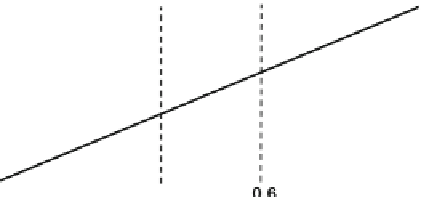Information Technology Reference
In-Depth Information
3.4.3 Examples
Example 3.4.9
Rule 'If
x
is big, then
y
=
0
.
8', with
x
,
y
in
[
0
,
1
]
, and the observation
x
∈[
0
.
4
,
0
.
6
]
. Hence:
x
,
if
y
=
0
.
8
J
(μ
B
(
x
), μ
{
0
.
8
}
(
y
))
=
x
·
μ
{
0
.
8
}
(
y
)
=
0
,
if
y
=
0
.
8
0
.
,
=
.
6
if
y
0
8
Then,
μ
Q
∗
(
y
)
=
Sup
min
(μ
[
0
.
4
,
0
.
6
]
(
x
),
x
μ
{
0
.
8
}
(
y
))
=
,
=
.
,
0
if
y
0
8
x
∈[
0
,
1
]
since,
D
Example 3.4.10
Rule: 'If
x
is big, then
y
is small', with the same observation as that
in the last example and with
μ
B
(
)
=
μ
S
(
)
=
−
(
,
)
=
(
,
)
x
x
,
y
1
y
, and
J
a
b
min
a
b
,
follows:
μ
Q
∗
(
y
)
=
Sup
x
∈[
min
(μ
[
0
.
4
,
0
.
6
]
(
x
),
min
(
x
,
1
−
y
))
=
Sup
x
∈[
min
(
min
(μ
[
0
.
4
,
0
.
6
]
(
x
),
0
,
1
]
0
,
1
]
x
),
1
−
y
)
=
Sup
min
(
x
,
1
−
y
)
=
min
(
0
.
6
,
1
−
y
).
x
∈[
0
,
1
]
Example 3.4.11
X
={
1
,
2
,
3
}
,
Y
={
6
,
7
}
. Rule: 'If
x
is around 2, then
y
=
6', and
μ
P
∗
(
x
)
=
0
.
6
/
1
+
0
.
9
/
2
+
0
.
7
/
3, with
J
(
a
,
b
)
=
ab
(Larsen). It results
⊛
⊞
0
50
10
0
.
⊝
⊠
=
(
(μ
Q
∗
(
6
), μ
Q
∗
(
7
))
=
(
0
.
60
.
90
.
7
)
↗
0
.
90
.
7
)
, that is
μ
Q
∗
=
0
.
9
/
6
+
.
50
0
/
7.
Example 3.4.12
With
x
∈[
0
,
1
]
, and
y
∈[
0
,
1
]
, consider
•
r1:'If
x
is big, then
y
is small', represented by
J
1
(
,
)
=
a
b
ab
•
r2:'If
x
is very small, then
y
is very big', represented by
J
2
(
,
)
=
(
,
)
a
b
min
a
b
2
,
y
2
.
Consider
x
0
=
0
.
4,
μ
B
(
x
)
=
x
,
μ
S
(
y
)
=
1
−
y
,
μ
VS
(
x
)
=
(
1
−
x
)
μ
VB
(
y
)
=
Then










Search WWH ::

Custom Search